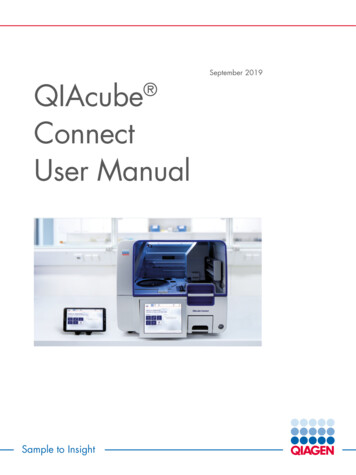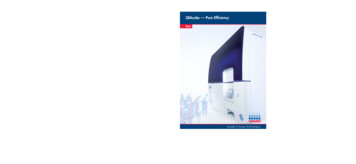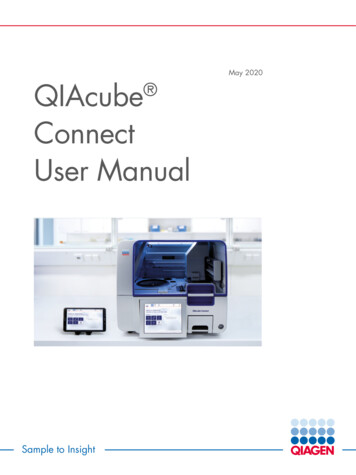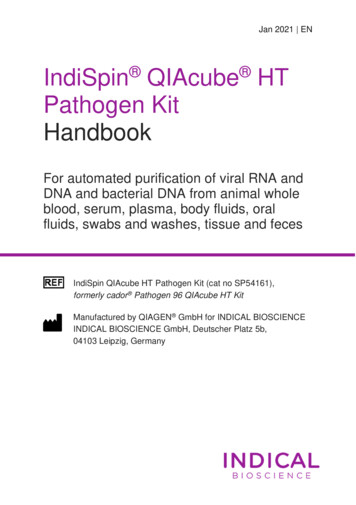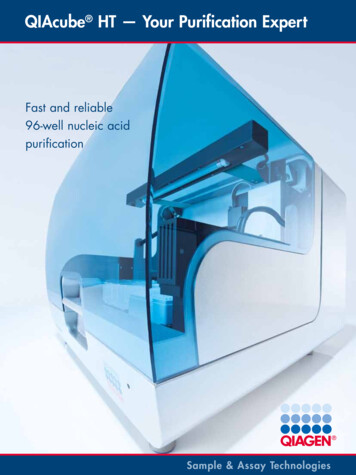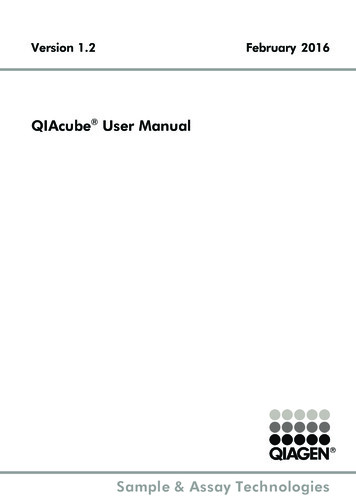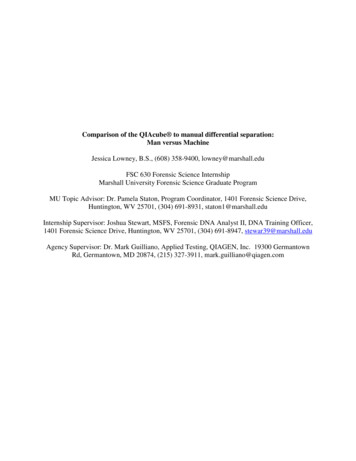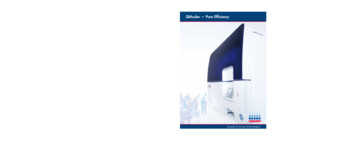
Transcription
August 2016QIAamp 96 VirusQIAcube HT HandbookFor automated purification of viral RNA andDNA from human samples using QIAcube HTand QIAcube HT Prep Manager SoftwareSample to Insight
ContentsKit Contents . 4Storage . 5Intended Use . 5Safety Information . 6Quality Control. 6Introduction . 7Principle and procedure . 7Description of protocols. 7Nucleic acid purification protocol. 8Pretreatments . 8Equipment and Reagents to Be Supplied by User . 10Important Notes . 12Starting materials . 12Yields of nucleic acids. 15Using carrier RNA and internal controls . 16Storing nucleic acids . 16Handling RNA . 16Preparing RNA . 17Preparing reagents and instrument. 17Assembling the vacuum chamber. 19Optional features . 21Processing fewer than 96 samples per run . 21QIAamp 96 Virus QIAcube HT Handbook 08/20162
Off-board lysis . 21QIAamp Virus Protocol . 22Things to do before starting . 22Manual lysis procedure . 23QIAamp virus protocol on the QIAcube HT. 23Cleaning the instrument after completing a run . 27Optional steps. 28Advanced options . 30Sample Pretreatment Protocols . 34Pretreatment B1 for Respiratory Samples . 34Pretreatment B2 for Liquid Transport Media . 35Pretreatment B3 for Urine . 35Pretreatment B4 for Dried Blood Spots . 36Pretreatment B5 for Swabs and Buccal Cells . 36Pretreatment F1 for Stool Suspensions . 37Pretreatment T1 Mechanical Disruption of Tissue . 37Pretreatment T2 for Enzymatic Digestion of Tissue . 38Troubleshooting Guide . 40Appendix A: General Remarks on Handling RNA. 43Ordering Information . 46Quick-Start Protocol . 483QIAamp 96 Virus QIAcube HT Handbook08/2016
Kit ContentsQIAamp 96 Virus QIAcube HT KitCatalog no.(5)57731Number of prepsQIAamp 96 platesBuffer ACL*48051 x 220 mlBuffer ACB*† (concentrate)3 x 60 mlQIAGEN Proteinase K3 x 6 mlCarrier RNA (poly A)2 x 310 µgBuffer ATL2 x 50 mlBuffer AW1* (concentrate)1 x 190 mlBuffer AW2 (concentrate)1 x 127 mlBuffer AVE§1 x 125 ml‡‡TopElute FluidQuick-Start Protocol1 x 60 ml1* CAUTION: Contains a chaotropic salt. Take appropriate laboratory safety measures and wear gloves when handling.Not compatible with disinfectants containing bleach. See page 6 for safety information.†Before using for the first time, add isopropanol as indicated on the bottle to obtain a working solution.‡Before using for the first time, add ethanol (96–100%) as indicated on the bottle to obtain a working solution.§CAUTION: Contains sodium azide as a preservative.QIAcube HT PlasticwareCatalog no.Number of prepsS-BlocksFilter-Tips OnCor C(480)95006748059 x 96Tape Pad1Elution Microtubes RS (EMTR)58-Well Strip Caps for EMTRQIAamp 96 Virus QIAcube HT Handbook 08/20161204
StorageQIAamp 96 plates, buffers and lyophilized carrier RNA are stable until the expiration dateon the kit box at room temperature (15–25 C) and dry conditions without affectingperformance.Freeze Carrier RNA dissolved in Buffer AVE immediately in aliquots at –30 to –15 C. Do notsubject aliquots of carrier RNA to more than 3 freeze–thaw cycles. Carrier RNA dissolved inBuffer AVE is stable at room temperature (15–25 C) for up to 48 hours (see “Preparingreagents and instrument” on page 17 for further information).QIAGEN Proteinase K can be stored at room temperature (15–25 C). To store for extendedperiods of time, or if the ambient temperature often exceeds 25 C, we recommend storing at2–8 C.Intended UseThe QIAamp 96 Virus QIAcube HT Kit is intended for the automated extraction of viral RNAand DNA from human whole blood, serum, plasma, body fluids, swabs, washes, tissue andstool using the QIAcube HT instrument. The QIAamp 96 Virus QIAcube HT Kit is intended formolecular biology applications. This product is not intended for the diagnosis, prevention, ortreatment of a disease.All due care and attention should be exercised in the handling of the products. Werecommend all users of QIAGEN products to adhere to the NIH guidelines that have beendeveloped for recombinant DNA experiments, or to other applicable guidelines.5QIAamp 96 Virus QIAcube HT Handbook08/2016
Safety InformationWhen working with chemicals, always wear a suitable lab coat, disposable gloves andprotective goggles. For more information, please consult the appropriate safety data sheets(SDSs). These are available online in convenient and compact PDF format atwww.qiagen.com/safety where you can find, view and print the SDS for each QIAGEN kitand kit component.CAUTION: DO NOT add bleach or acidic solutions directly to the samplepreparation waste.Buffer ACL and Buffer ACB contain guanidine thiocyanate and Buffer AW1 containsguanidine hydrochloride, which can form highly reactive compounds if combined withbleach.If liquid containing these buffers is spilled, clean with suitable laboratory detergent andwater. If the spilled liquid contains potentially infectious agents, clean the affected area firstwith laboratory detergent and water, and then with 1% (v/v) sodium hypochlorite.Quality ControlIn accordance with QIAGEN’s ISO-certified Quality Management System, each lot ofQIAamp 96 Virus QIAcube HT Kit is tested against predetermined specifications to ensureconsistent product quality.QIAamp 96 Virus QIAcube HT Handbook 08/20166
IntroductionThe QIAamp 96 Virus QIAcube HT Kit uses well-established technology to enable efficientpurification of viral RNA and DNA from a broad range of sample types (see Table 1 onpage 9).The kit combines the selective binding properties of a silica-based membrane with a highthroughput 96-well format, and is designed for fully-automated, simultaneous processing of96 samples on the QIAcube HT. Purified nucleic acids are eluted in Buffer AVE, and are freeof proteins, nucleases and other impurities, ready for use in downstream applications. The kitis not intended for host RNA or host DNA preparation.Principle and procedureSamples are lysed under highly denaturing conditions at room temperature in the presenceof QIAGEN proteinase K and Buffer ACL, which together ensure the inactivation ofnucleases. Adding Buffer ACB adjusts the binding conditions for the co-purification of DNAand RNA. The lysate is then transferred to a QIAamp 96 plate. During vacuum, nucleicacids are adsorbed onto the silica membranes while contaminants pass through. Threeefficient wash steps remove the remaining contaminants and enzyme inhibitors, and nucleicacids are eluted in Buffer AVE.Performance is not guaranteed for every combination of starting material and virus speciesand must be validated by the user. Some samples may require a pretreatment (see Table 1on page 9).Description of protocolsSamples will either directly undergo nucleic acid purification, or undergo pretreatmentfollowed by nucleic acid purification.7QIAamp 96 Virus QIAcube HT Handbook08/2016
Many sample types can be directly processed without pretreatment. However, depending onthe starting material, a sample pretreatment may be needed. Table 1 provides an overviewof pretreatment protocols suited to different starting materials. This handbook includes thefollowing protocols: QIAamp Virus Protocol (page 21) Sample Pretreatment Protocols (pages 34–39)Nucleic acid purification protocolThe protocol “QIAamp Virus Protocol”, page 21, is optimized for purification of viral RNAand DNA from up to 200 µl of fluid material. Suitable starting materials for direct processingusing this method include: Cell-free body fluids such as plasma, serum and CSF Whole bloodPretreatmentsThe various pretreatments included in this handbook are optimized for specific combinationsof starting material. The choice of pretreatment depends on the workflow focus, and is to befollowed by nucleic acid purification. Table 1 on page 9 summarizes the pretreatments andtheir applications.Some of the pretreatments may require additional components (see pages 10–11).QIAamp 96 Virus QIAcube HT Handbook 08/20168
Table 1. Pretreatment protocols for various sample typesSampleNamePageFluids(e.g., plasma and serum*, cell-freebody fluids*†, whole blood†‡)No pretreatment necessary; proceed directly with “QIAampVirus Protocol”21Respiratory samples and sputum§Pretreatment B1 for Respiratory Samples34Liquid transport mediaPretreatment B2 for Liquid Transport Media35UrinePretreatment B3 for Urine35Dried blood spotsPretreatment B4 for Dried Blood Spots36Swabs and buccal cellsPretreatment B5 for Swabs and Buccal Cells36Stool suspensionsPretreatment F1 for Stool Suspensions37Tissues(e.g., liver, spleen, kidney, lymphnode)Pretreatment T1 Mechanical Disruption of Tissue37Pretreatment T2 for Enzymatic Digestion of Tissue¶38*Samples can be fresh or frozen, provided they have not been frozen and thawed more than once.†Includes amniotic fluid, cerebrospinal fluid, ocular fluid, synovial fluid and pleural fluid.‡Includes samples containing EDTA or citrate.§Includes nasopharyngeal aspirates (NPA), bronchoalveolar lavage (BAL) fluid, sputum and nasal and throat swabs.¶Not suitable for viral RNA as the lysis conditions do not sufficiently conserve RNA integrity.9QIAamp 96 Virus QIAcube HT Handbook08/2016
Equipment and Reagents to Be Supplied by UserWhen working with chemicals, always wear a suitable lab coat, disposable gloves andprotective goggles. For more information, consult the appropriate safety data sheets (SDSs),available from the product supplier.For all protocols: Pipets and disposable pipet tips with aerosol barriers (20–1000 µl) Isopropanol Ethanol (96–100%) * Phosphate-buffered saline (PBS) may be required for sample dilution QIAcube HT Instrument QIAcube HT Prep Manager Software QIAcube HT Reagent troughs VortexerPretreatment B1 – for respiratory samples Sputasol (Oxoid Limited) and 37 C water bath, or NAC buffer (10 g N-acetylcysteine per liter of 0.9% NaCl solution), or PBS or Buffer AE (cat. no. 19077), DTT and 37 C water bathPretreatment B2, B3, B4 and B5 – for liquid transport media, urine and dried bloodspots Buffer ATL (cat. no. 19076) QIAGEN Proteinase K (cat. nos. 19131 or 19133)* Do not use denatured alcohol, which contains other substances such as methanol or methylethylketone.QIAamp 96 Virus QIAcube HT Handbook 08/201610
Pretreatment F1 — stool samples 0.9% NaCl solutionPretreatment T1 – mechanical disruption of tissue TissueLyser II (QIAGEN, cat. no. 85300) with a TissueLyser II Adapter Set 2 x 24(QIAGEN, cat. no. 69982), or TissueLyser LT (QIAGEN, cat. no. 85600) with theTissueLyser LT Adapter for 12 tubes (QIAGEN, cat. no. 69980), or other bead-millhomogenizer * 5 mm stainless steel beads (cat. no. 69989) Buffer ATL (cat. no. 19076) QIAGEN Proteinase K (cat. nos. 19131 or 19133)Pretreatment T2 – enzymatic digestion of tissue Thermoshaker suitable for 2 ml collection tubes Buffer ATL (cat. no. 19076) QIAGEN Proteinase K (cat. nos. 19131 or 19133)* This is not a complete list of suppliers and does not include many important vendors of biological supplies.11QIAamp 96 Virus QIAcube HT Handbook08/2016
Important NotesStarting materialsDo not overload the QIAamp membrane, as this can lead to impaired nucleic acid extractionand/or performance in downstream assays. For samples with very high host nucleic acidcontents (e.g., for certain tissues, such as spleen or blood samples with highly increased cellcounts), use less than the maximum amount of sample recommended in the protocol orpretreatments. In some downstream applications such as PCR and RT-PCR, very highbackground concentrations of nucleic acids may impair the reaction. Use appropriatecontrols (e.g., an internal control) to verify successful PCR amplification.Avoid transferring solid material to the S-Block that could reduce flow through the membrane(e.g., blood clots, solid tissue, swab fibers, etc.). When working with difficult samples, use avacuum performance step to check if all liquid has passed the membrane. See“Troubleshooting Guide” on page 40 and the QIAcube HT User Manual for guidance.Highly viscous fluids may require a treatment to reduce their viscosity to allow for efficientextraction of viral nucleic acids.Avoid repeated thawing and freezing of samples since this may reduce nucleic acid yieldand quality.Serum, plasma, other body fluids and swab mediaUp to 200 µl serum, plasma, other body fluid or swab media supernatant can be processed.Carrier RNA should be used in the nucleic acid purification protocol to prevent the loss ofnucleic acids during the procedure (see page 16 for information about the use of carrierRNA).QIAamp 96 Virus QIAcube HT Handbook 08/201612
The processing of samples with very high inhibitor contents, such as urine or stool, may requirea reduction in sample input volume and/or an extra pretreatment to remove inhibitors. Toreduce the input volume, use 25–50 µl of the sample and adjust the volume to 200 µl with PBSor 0.9% NaCl.Plasma and serum samplesAfter collection, centrifugation and phase separation, plasma or serum can be stored at2–8 C for up to 6 hours. For long-term storage, freezing at –30 to –15 C or –70 C inaliquots is recommended. Frozen plasma or serum samples must not be thawed more thanonce. Repeated freeze–thawing leads to reduced viral titers and therefore reduced yields ofviral nucleic acids.Freezing of samples can lead to denaturation and precipitation of proteins that mayaggregate on the QIAamp membrane. If cryo-precipitates are visible, they can be pelletedby centrifugation at 6800 x g for 3 minutes. The cleared supernatant should be transferredto a new sample tube without disturbing the pellet and processed immediately. This step willnot reduce viral titers.SwabsSwabs may be processed on the same day as collection or stored for future processing.While storage at –30 to –15 C is recommended, DNA of suitable quality for single-copygene amplification has been documented from swabs stored at room temperature for 24months.Alternatively, samples can be collected using plastic swabs with cotton or Dacron tips.Puritan applicators with plastic shafts and cotton or Dacron tips are available fromHardwood Products Company (www.hwppuritan.com, cat. nos. 25-806 1PC and 25-80613QIAamp 96 Virus QIAcube HT Handbook08/2016
1PD) and from Daigger (www.daigger.com, cat. nos. EF22008D and EF22008DA). * Nyloncytology brushes and other swab types may also be used.Note: Solid pieces remaining in the sample fluid may aggregate on the QIAamp membrane,which may decrease nucleic acid yield.Whole bloodBlood samples treated with EDTA or citrate as anticoagulant can be used for nucleic acidpurification. Samples can be either fresh or frozen, provided that they have not been frozenand thawed more than once. After collection, whole blood samples can be stored at 2–8 galiquotsat–30 to –15 C or –70 C.We recommend using 50–200 µl blood per sample. Typically, 200 µl of blood can be usedwith most blood samples. However, highly elevated cell counts due to inflammatory orneoplastic diseases may strongly increase the host nucleic acid content of a sample. In thiscase, reduction of sample input to 50 µl may improve results in downstream assays,particularly in RT-PCR. If using less than 200 µl blood, adjust the sample volume to 200 µlwith PBS or 0.9% NaCl.Dried blood spotsDrying blood on filter paper (e.g., Whatman FTA Cards) is an effective form of storage, andsamples prepared in this manner are less expensive and safer to transport. A disc (3 mmdiameter) punched out from filter paper stained with dried blood contains white blood cellsfrom approximately 5 µl whole blood.* This is not a complete list of suppliers and does not include many important vendors of biological supplies.QIAamp 96 Virus QIAcube HT Handbook 08/201614
TissuesWhen working with tissue samples, mechanical or enzymatic disruption of the tissue structureis the prerequisite for liberation of cells, subsequent release of nucleic acids, and membranepermeability of the material.Different tissue types can vary widely with regard to texture and rigidity, cell types andcontent of host nucleic acids and inhibitory substances. In addition, the localization of viralnucleic acids in the tissue may vary depending on tissue type, virus and stage of infection.Up to 5 mg of fresh or frozen tissue can be used as a starting amount. For higher amounts oftissue it might be necessary to check whether this amount of tissue can still be processed.Furthermore we recommend enabling the vacuum performance check during the vacuum stepto ensure that the liquids have completely passed through the membrane before the protocolproceeds.Yields of nucleic acidsFor samples containing a low amount of cells (e.g., serum and plasma), the yield of nucleicacids obtained can be below 1 µg and is therefore difficult to quantify using aspectrophotometer. In addition, eluates prepared with carrier RNA may contain much morecarrier RNA than target nucleic acids. The QIAamp 96 Virus QIAcube HT Kit recovers totalnucleic acids. Therefore, cellular DNA and RNA and circulating cell-free nucleic acids willbe co-purified along with viral RNA and DNA (and bacterial nucleic acid if present) andcannot be distinguished using spectrophotometric measurements. We recommend usingquantitative amplification methods such as quantitative real-time PCR or real-time RT-PCR todetermine viral nucleic acid yields.15QIAamp 96 Virus QIAcube HT Handbook08/2016
Using carrier RNA and internal controlsCarrier RNAWe recommend adding carrier RNA to fluids containing low amounts of cells such as serum,plasma, swab media and wash fluid. This enhances adsorption of viral RNA and DNA to thesilica membranes, which is especially important when the target molecules are not abundant.In addition, an excess of carrier RNA reduces the chances of viral RNA degradation in therare event that RNases are not denatured by the chaotropic salts and detergents in the lysisbuffer. Not using carrier RNA may decrease the recovery of viral nucleic acids.Internal controlUsing the QIAamp 96 Virus QIAcube HT Kit in combination with commercially availableamplification systems may require the introduction of an internal control into the purificationprocedure. Internal control RNA or DNA should be added together with the carrier RNA tothe lysis buffer (see Table 2 on page 26). Refer to the assay manufacturer’s instructions inorder to determine the optimal concentration.For the standard protocol, it is recommended to add 5 µl internal control solution. Using aconcentration other than that recommended may reduce amplification efficiency.Storing nucleic acidsFor short-term storage of up to 24 hours, we recommend storing the purified viral RNA andDNA at 2–8 C. For storage longer than 24 hours, we recommend storing purified nucleicacids at –30 to –15 C, or even –70 C in the case of RNA.Handling RNARNases are very stable and active enzymes that generally do not require cofactors tofunction. Since RNases are difficult to inactivate and only minute amounts are sufficient toQIAamp 96 Virus QIAcube HT Handbook 08/201616
destroy RNA, do not use any plasticware or glassware without first eliminating possibleRNase contamination. Care should be taken to avoid inadvertently introducing RNases intothe RNA sample during or after the purification procedure.Preparing RNAWhen preparing viral RNA, work quickly during the manual steps of the procedure. If youhave not previously worked with RNA, read Appendix A on page 43 before starting. BufferAVE is RNase-free upon delivery. It contains sodium azide, an antimicrobial agent thatprevents growth of RNase–producing organisms. However, as this buffer does not containany RNase inhibitors, it will not actively inhibit RNases introduced by inappropriatehandling. Extreme care should be taken to avoid contamination with RNases when handlingBuffer AVE.Preparing reagents and instrumentCarrier RNA stock solutionFor use, lyophilized carrier RNA should first be dissolved in Buffer AVE. Add 1550 µl BufferAVE to the tube containing 310 µg lyophilized carrier RNA to obtain a stock solution of0.2 µg/µl. Add this solution to Buffer ACL as described in Table 2 on page 26. Unusedcarrier RNA dissolved in Buffer AVE should be frozen in aliquots at –30 to –15 C. Aliquotsof carrier RNA should not be subjected to more than 3 freeze–thaw cycles.QIAGEN Proteinase KThe QIAamp 96 Virus QIAcube HT Kit contains ready-to-use QIAGEN Proteinase K suppliedin a specially formulated storage buffer. The activity of the QIAGEN Proteinase K solution is600 mAU/ml.17QIAamp 96 Virus QIAcube HT Handbook08/2016
QIAGEN Proteinase K is stable for at least 1 year after delivery when stored at roomtemperature (15–25 C). To store for more than 1 year or if ambient temperature oftenexceeds 25 C, we recommend storing QIAGEN Proteinase K at 2–8 C.Buffer ACBBuffer ACB is supplied as a concentrate. Before using for the first time, add isopropanol(100%) as indicated on the bottle to obtain a working solution. Tick the check box on thebottle label to indicate that isopropanol has been added. Mix well after adding isopropanol.Buffer AW1Buffer AW1 is supplied as a concentrate. Before using for the first time, add ethanol (96–100%) as indicated on the bottle to obtain a working solution. Tick the check box on thebottle label to indicate that ethanol has been added. Mix well after adding ethanol.Buffer AW2Buffer AW2 is supplied as a concentrate. Before using for the first time add ethanol (96–100%) as indicated on the bottle to obtain a working solution. Tick the check box on thebottle label to indicate that ethanol has been added. Mix well after adding ethanol.Handling Buffer AVEBuffer AVE is RNase-free upon delivery. It contains sodium azide, an antimicrobial agent thatprevents growth of RNase-producing organisms. However, as this buffer does not containany RNase-degrading chemicals, it will not actively inhibit RNases introduced byinappropriate handling. For RNA applications, when handling Buffer AVE, avoidcontamination with RNases. Follow general precautions for working with RNA, such asfrequent change of gloves and keeping tubes closed whenever possible.QIAamp 96 Virus QIAcube HT Handbook 08/201618
TopElute FluidTopElute Fluid is used during elution of nucleic acids from the QIAamp membrane. It enablesapplication of a stable and high vacuum and results in equal eluate volumes. In addition,TopElute Fluid eliminates the formation of drops of elution buffer at the outlet nozzles of theQIAamp 96 plates.TopElute Fluid might be found as a top layer over the elution buffer. It is inert and has noeffects on downstream applications.Important: Please ensure that you only take the eluate from below the top layer.Assembling the vacuum chamberFigure 1 illustrates the assembly of the vacuum chamber. For further information, please referto the QIAcube HT User Manual.1. Insert the channeling block holder into the left (waste) chamber of the vacuum chamber.2. Press firmly on the sides of the channeling block holder to seat it in the chamber, sealingthe O-ring on the spigot into the drain.3. Then, place the channeling block into the channeling block holder.4. Place the QIAamp 96 plate in the transfer carriage. Load the carriage with the QIAamp96 plate into the left (waste) chamber of the vacuum chamber.5. Ensure that the carriage is positioned to the left inside the vacuum chamber. Place theriser block EMTR in the right (elution) chamber of the vacuum chamber with the pin of theriser block EMTR in the top right position.6. Load an elution microtubes rack (EMTR) into the elution chamber.19QIAamp 96 Virus QIAcube HT Handbook08/2016
96-well plate(e.g., QIAamp 96 plate)Transfer carriage(cat. no. 9022654)Channeling adapter(cat. no. 9022656)Contains:Channeling block(cat. no. 9022665)Channeling block holder(cat. no. 9022664)Elution microtubes (EMTR)Riser block EMTR(cat. no. 9022655Vacuum chamberFigure 1. Assembling the vacuum chamber.QIAamp 96 Virus QIAcube HT Handbook 08/201620
Optional featuresProcessing fewer than 96 samples per runIf processing fewer than 96 samples reuse of QIAamp 96 plates, S-Block and EMTR ispossible up to three times.Note: We recommend using fresh plasticware for every run. If reusing, take extreme care toprevent cross-contamination. Store plates in a way that separates the outlet nozzles under the plate, for example, inthe S-Block used in the same run or in a fresh 96-well microtiter plate. Cover unused wells of the S-Block and QIAamp 96 plate with a tape sheet at all times.Off-board lysisFor some applications, it may be necessary to lyse samples in a safety cabinet. For somesample types, lysis outside the instrument might be necessary. Please refer to SamplePretreatment Protocols on pages 34–39.When using an off-board lysis protocol, choose the QIAamp virus off-board lysis protocol inthe software setup step under the selected protocol.21QIAamp 96 Virus QIAcube HT Handbook08/2016
QIAamp Virus ProtocolThis protocol is for the purification of viral nucleic acids from diverse samples. See Table 1on page 9 for sample pretreatments. There are two types of protocols: QIAamp virus protocol: this protocol starts with the lysis of the samples after a necessarypretreatment. QIAamp virus off-board lysis protocol: this protocol starts with adding the binding bufferto manually lysed samples.Things to do before starting Ensure all reagents and samples are equilibrated to room temperature (15–25 C). Check for precipitates in reagents. If a reagent contains precipitates, incubate at 37 Cwith gentle shaking to dissolve precipitates. Avoid vigorous shaking, which causesfoaming. Check that Buffer ACB, Buffer AW1, Buffer AW2 and carrier RNA have been preparedaccording to the instructions in ”Preparing reagents and instrument” (page 17). When working with difficult samples, use a vacuum performance check to check if allliquid has passed the membrane. See “Troubleshooting Guide” on page 40 and theQIAcube HT User Manual for guidance. Ensure that the relevant version of the QIAamp 96 Virus protocol is available on thecomputer.QIAcube HT Prep Manager protocol files (file extension *.qpmx), which contain all theinformation required to perform a run on the QIAcube HT instrument, are available fromwww.qiagen.com/p/QIAcubeHT, under the Resources tab. Ensure that QIAcube HT Prep Manager Software is installed. Ensure that you are familiar with operating the instrument. Refer to the QIAcube HT UserManual for operating instructions.QIAamp 96 Virus QIAcube HT Handbook 08/201622
If the volume of the samples is less than 200 µl, add PB
Sample to Insight_ August 2016 . QIAamp 96 Virus QIAcube HT Handbook . For automated pu rification of viral RNA and DNA from human samples using QIAcube HT and QIAcube HT Prep Manager Software

